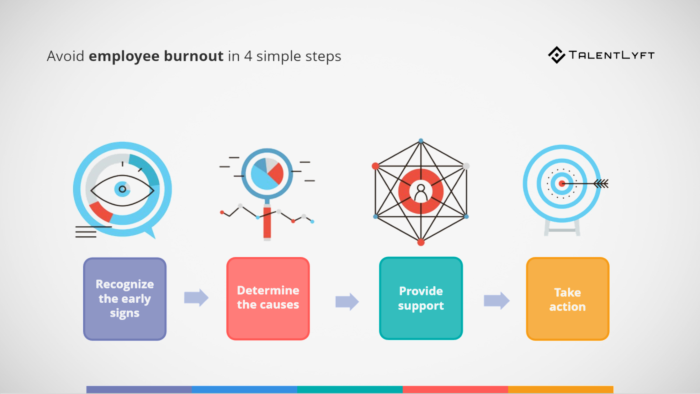![https://adoptoprod.blob.core.windows.net/article/eNOg3UAQvkKYJxuKQ37EJA.png?7]()
Why do you need to worry about employee burnout?
Employee burnout can have disastrous effects on your business.
It can increase errors on the job, lower the productivity of your employees, create interpersonal conflicts, increase absenteeism from work and cause high turnover.
A survey of 614 HR professionals found that 95 percent of HR leaders said employee burnout was sabotaging workforce retention. 😲

Obviously, employee burnout is a huge problem for many companies.
It is the reason many companies lose their employees. Especially talented ones.
Burnout is a talent issue.
Because of their personality traits, top performers are especially prone to burnout.
In order to avoid burnout and retain their employees, HR professionals must have a good knowledge about burnouts, its symptoms, causes and effective ways to prevent it.
What is employee burnout?
“Employee burnout” is the term used to describe the state of physical, emotional or mental exhaustion in employees.
Employee burnout occurs as a result of a long-term stress at work.
When left unmanaged, workplace-related stress can become chronic and cause a major breakdown, called burnout.
In a state of burnout, employees are no longer able to function effectively on a personal or professional level. They feel overwhelmed and unable to meet daily demands.
How to recognize the signs of burnout in employees?
Employee burnout doesn't happen overnight.
It is a gradual process that takes time to develop.
This process starts with subtle warning signals.
If you don't pay attention to these signals and if they are not properly managed, they get worse and worse as time goes on, until they finally escalate in the major breakdown - a burnout.
According to doctors and therapists, there are 4 main phases of employee burnout development.
It is important that you learn to differentiate each of these stages. That way you can recognize the early signs of burnout and address them on time before they escalate into full throttle burnout with serious consequences.
In order to be able to recognize the early signs of burnout and address them on time, you need to get familiar with each of these stages.
4 main phases of employee burnout
1. Honeymoon phase
In this phase, employees feel excessive work enthusiasm. They are completely immersed in their job. They say yes to every demand and take on plenty of work, but feel positively stimulated and excited by it. However, in this state, they tend to develop very high expectations and set up idealistic goals.
2. Hard working phase
In this phase, employees work hard to achieve previously set goals. However, long working hours, overtime and demanding job tasks start taking their toll. Employees start experiencing the first signs of physical and mental tiredness. They feel frustrated and irritated and start questioning their expertise.
3. Stressed out phase
In this phase, employees feel constantly pressured with unattainable job demands. They have trouble concentrating on the job and feel disappointed and angry. They exhibit negative attitudes and behaviors. They may lash out at their coworkers or clients. At the same time, they struggle with physical symptoms such as constant tiredness, sleep problems, regular headaches, appetite changes etc.
4. Burnout phase
In this phase, employees are no longer able to handle the pressures at work. Their mental and physical reserves are completely depleted. They slip into extreme cynicism or depression and become inefficient. As a result, they experience an overwhelming sense of failure and lose interest in their job.
Employee burnout symptoms
A final stage of burnout is characterized by serious symptoms on 3 levels:
1. Physical
- Sleep problems
- Appetite changes
- Headaches
- Shortness of breath
- High blood pressure
- Heart palpitations
- Dizziness
2. Emotional
- Anxiety
- Depression
- Tension
- Irritability
- Angry outbursts
3. Mental
- Forgetfulness
- Lack of concentration
- Disorganization
- Indecisiveness
- Pessimism

In short, if your employees exhibit increased absenteeism, decreased engagement, reduced productivity, pessimism and explosive reactions, they might be suffering from the serious case of burnout.
What causes employee burnout?
Burnout is a multidimensional response (physical, mental and emotional) with many complex causes (personal, organizational and social).
Each individual reacts differently, there is no definite cause of burnout. However, there are some common factors found in all burnout cases.
Some common work-related stressors include:
- Excessive workloads
- Time pressure
- Interpersonal relationships at work
- Poor work-life balance
- Lack of job security
- Low salaries
You should also keep in mind that employees with certain traits will be more vulnerable to burnout.
Over-achievers, perfectionist and pessimists are especially susceptible to burnout.
How to avoid employee burnout?
Here is how to avoid employee burnout in 4 simple steps:
1. Recognize the early burnout signs
If you want to avoid employee burnout, you must recognize it in its early phase.
Pay attention to your employees and be observant.
If you work in a large company and you can’t regularly interact with all employees, a good idea is to reach out to other managers and team leads. Educate them on the importance of burnout prevention and help them spot early warning signs of burnout.
You can also send out emails and ask employees to take the self-assessment burnout test.
More sophisticated solutions are online survey software.
For example, with a cool tool called Survio, you can create online surveys for free using their burnout survey template.
Online survey platform QuestionPro is another good example. Their employee engagement survey includes “Employee job stress evaluation”.
2. Determine the burnout causes
If you are an HR manager who has noticed burnout symptoms in your employees, you should proceed by determining the burnout causes.
Identifying the burnout causes can usually be achieved through discussion with the affected individual (or the group).
I suggest inviting your employees for an informal meeting outside of your office. This will help you prevent interruptions, ensure privacy and set up a more relaxed atmosphere.
Try to find out if there is something your employees have difficulties coping with. Ask open questions and give them an opportunity to explain what they are experiencing. You can use Individual Stressor Questionnaire (ISQ) as your guide.
3. Provide support
Before you jump right into solving the problem, stop for a second and focus on the burnt out employees in front of you. Remember that they were once passionate, committed employees who got in this state because they worked so hard. They probably feel ashamed, disappointed in themselves, lonely and isolated.
Give them emotional support that they need and remind them that they are valued and cared for by their team and company.
Ask them what they need to recover as soon as possible. Make sure you take care of their health first and then move on to fixing the problem.
Of course, in order to provide support, you first have to be okay yourself and know how to stay positive at work despite challenges and stress.
4. Take action
Now it’s time to get down to work. You need to roll up your sleeves, analyze the problem, devise a solution, and act.
At this point, it is crucial to discern whether you are dealing with an issue that is problematic for this one particular employee or you stumbled upon an organizational issue which can negatively affect your other employees too.
For example, if your burnt out employees are complaining about the excessive workload, you can help by providing time management tips and teaching them how to set boundaries and say no assertively.
They may, however, have perfect time management skills and still suffer from excessive workload forced upon by their manager, who is also suffocating with a heavy workload and stressed out. In this case, you are dealing with the organizational problem which requires a different solution.
In other words, make sure you are addressing the real underlying cause of the problem, not just with its visible symptoms.

HR Professionals, what do you do to avoid employee burnout?
Hopefully, these tips will help you understand burnout better and prevent it in order to maintain a positive work environment and keep your employees happy, engaged and productive.
Is an employee burnout an issue for your company too?
Do you have a great tip for preventing employee burnout? Let us know in the comments! 🙂
Looking for a new recruitment solution?
TalentLyft helps you optimize your recruitment process from start to finish! Become more successful at finding and attracting qualified candidates and improve candidate experience for in every stage of the recruitment process. If you want to learn more, make sure to book a quick call with one of our product specialists.
Book a quick call 












![[GUIDE] How to Segment Your Talent Pool](https://adoptostaging.blob.core.windows.net/article/0pOm3nwXhEm6SEPThfIO2Q.png?8619)

